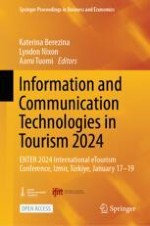1 Introduction
2 Data and Methodology
-
goal = “match review to the best fitting review topic from a list of topics”
-
steps = “1. Break the list of reviews onto separate reviews; 2. For each review find two best matching review topics from the list of review topics separated by the ‘;’ sign; 3. When there are no well-matching topics, assume that the topic is ‘Other’; 4. Print the review followed by the best matching topics”
-
actAs = “a classifier assigning a class label to a data input”
-
format = “a table with reviews in the first column …”
-
prompt = “Your goal is to {goal}, acting as {actAs}. To achieve this, take a systematic approach by: {steps}. Present your response in markdown format, following the structure: {format}. The list of review topics are as follows: {topics_str}”.
-
The list of reviews is as follows: {text}
3 Results
Topics | Weibo | YT | Overall |
|---|---|---|---|
Admiration & praise for Li Ziqi | 86% | 100% | 93% |
Curiosity about Li Ziqi background | 100% | 100% | 100% |
Desire to learn from Li Ziqi & replicate her creations | 92% | 91% | 92% |
Enthusiasm and support as a fan | 100% | 100% | 100% |
Li Ziqi beauty & resemblance to a princess | 92% | 88% | 90% |
Li Ziqi’s genuineness, sincerity, & trustworthiness | 100% | 100% | 100% |
Li Ziqi’s impact on viewers | 100% | 100% | 100% |
Li Ziqi’s role model status | 100% | 100% | 100% |
Animals (specifically dogs & sheep) | 100% | 100% | 100% |
Beauty and aesthetics of traditional life & products | 92% | 100% | 96% |
Desire to live a peaceful, natural, simple, self-sufficient life | 100% | 100% | 100% |
Nature & rural life | 100% | 100% | 100% |
Nostalgia & childhood memories | 100% | 100% | 100% |
Li Ziqi’s connection with her grandmother | 100% | 92% | 96% |
Chinese traditional crafts & skills | 100% | 92% | 96% |
Chinese traditional culture & heritage | 100% | 91% | 96% |
Art of calligraphy | 100% | 100% | 100% |
Food & cooking | 100% | 100% | 100% |
Topic words | Topic name | Acc. |
|---|---|---|
chinese; little; culture; admire; chinese culture; need; inherit; ability; music; inherit chinese | Chinese traditional culture & heritage | 35% |
life; live; place; wish; thank; beauty; nature; love; perfect; start | Beauty of living with nature | 55% |
love; cute; like; feel; sheep; lamb; follow; powerful; puppy; skill | Cute dogs & sheep | 40% |
girl; amazing; treasure; china; miss; think; home; sister; life; make | L. is amazing, treasure | 50% |
know; sister; happy; want; marry; fairy; snack; qiqi; good; want know | L. is fairy like, I want to marry her | 65% |
work; great; hard; lady; young; quot; malaysia; hard work; young lady; share | L is hard working | 40% |
want; house; make; time; fruit; grow; live; tree; build; candied | Interest in grounds, visiting, marriage | 60% |
look; paper; make; traditional; popcorn; chinese; brush; super; inkstone; wonderful | Traditional culture, craft, and cooking | 75% |
woman; make; awesome; world; best; mother; real; cook; amazing; feel | Admiration & praise for L | 65% |
good; thing; amaze; person; good good; heart; life; hungry; make; mickey | Expressions of enthusiasm | 65% |
beautiful; talented; strong; woman; make; people; wool; amazing; ancient; process | L. is beautiful, talented, and strong | 75% |
bamboo; time; grandma; make; hand; long; wear; glove; child; sofa | Traditional crafts, wear gloves! | 55% |
come; fairy; people; kind; update; kind fairy; mango; dislike; help; night | General support from fans | 75% |
